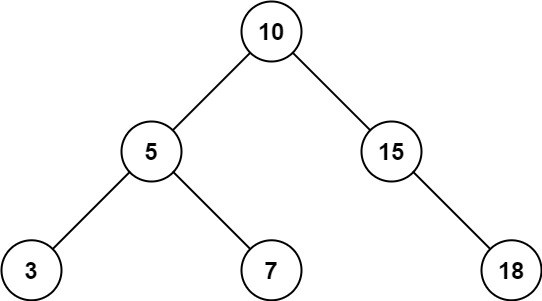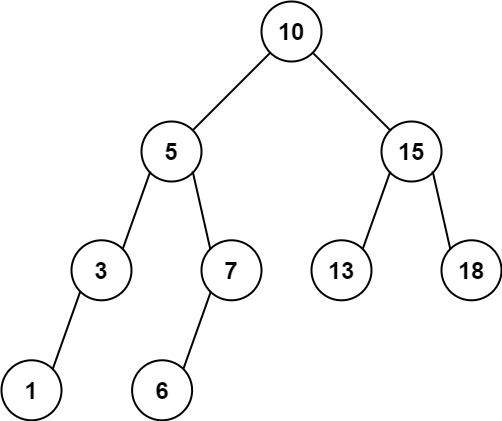LeetCode 938 Solution

Problem
Given therootnode of a binary search tree and two integerslowandhigh, return the sum of values of all nodes with a value in the inclusive range[low, high].
Example 1:

- Input: root = [10,5,15,3,7,null,18], low = 7, high = 15
- Output: 32
- Explanation: Nodes 7, 10, and 15 are in the range [7, 15]. 7 + 10 + 15 = 32.
Example 2:

- Input: root = [10,5,15,3,7,13,18,1,null,6], low = 6, high = 10
- Output: 23
- Explanation: Nodes 6, 7, and 10 are in the range [6, 10]. 6 + 7 + 10 = 23.
Binary Search Tree

A Binary Search Tree (BST) is a fundamental data structure that's essential in computer science for efficient data storage and retrieval. Here are the key points that highlight its importance and functionality:
- Definition and Structure:
- A BST is a tree structure where each node can have up to two children, referred to as the left and right child.
- The left child of a node always contains a value lesser than its parent node.
- The right child always contains a value greater than its parent node.
- This property must hold true for every subtree within the BST, not just the root.
- Efficient Search and Sorting:
- BSTs allow for efficient searching of data, as they leverage the property of binary search. In an average case, operations like search, insert, and delete have a time complexity of $O(log n)$.
- Inorder traversal of a BST yields the elements in a sorted order, making it useful for tasks that require ordered data.
- Imbalance Issues:
- The efficiency of a BST can significantly deteriorate depending on the order of data insertion. For instance, inserting sorted data into a BST can lead to a skewed tree, resembling a linked list, where operations might take O(n) time.
- Self-balancing binary search trees, such as AVL trees or Red-Black trees, are used to overcome this issue by maintaining a balanced height during insertions and deletions.
- Deletion Operation:
- Deleting a node in a BST can be more complex, especially if the node has children.
- If the node is a leaf (no children), it is simply removed.
- For a node with one child, the node is replaced with its child.
- For a node with two children, the node is generally replaced with its in-order predecessor (the maximum value in the left subtree) or successor (the minimum value in the right subtree), and then that predecessor or successor is deleted.
- Applications:
- BSTs are utilized in various areas such as database management, file systems, and search engine optimization due to their efficiency in handling ordered data.
python
# Definition for a binary tree node.
# class TreeNode:
# def __init__(self, val=0, left=None, right=None):
# self.val = val
# self.left = left
# self.right = right
class Solution:
def rangeSumBST(self, root: Optional[TreeNode], low: int, high: int) -> int:
result = 0
if root.val >= low and root.val <= high:
result += root.val
if root.left:
result += self.rangeSumBST(root.left, low, high)
if root.right:
result += self.rangeSumBST(root.right, low, high)
return result- Recursive search
- Use rangeSumBST recursively
- Time complexity minimize
- $O(n)$ of time complexity

